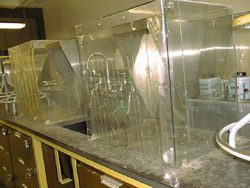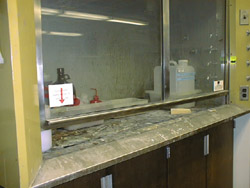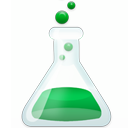Lab Safety
Topics:
- Protective gear
- Fire extinguishers
- Waste chemical handling
- Chemical hygiene safety plan
- Overview of how to handle hazardous chemicals
- Glassware safety
- Equipment and electrical safety
- Lab Safety Movie on Youtube
The responsibility for lab safety rests with each and every student in the laboratory. You must use common sense and work carefully to avoid chemical spills, broken glassware, and fires. This ensures not only your own safety, but that of your labmates. Know the hazards of each chemical you use so that you will know what level of caution to use when handling it. If you do this, you will not be exposed to a harmful amount of any chemical during your year in organic chemistry lab.
If an accident does happen, you must take steps to prevent further injury. Most accidents are minor, and methods of dealing with them are detailed in the sections below. In the event of a serious accident, remember that injured people are often in shock and are unable to help themselves. You should be prepared to help your neighbor in case of an accident. A matter of seconds can be critical.
Chemical Hygiene Safety Plan
OSHA regulations (29 CFR) governing occupational exposure to hazardous chemicals in laboratories are linked below. These regulations require the adoption of a Chemical Hygiene Plan (CHP) for facilities using hazardous chemicals:
Where hazardous chemicals as defined by this standard are used in the workplace, the employer shall develop and carry out the provisions of a written Chemical Hygiene Plan which is capable of protecting employees from health hazards associated with hazardous chemicals in that laboratory and capable of keeping exposures below the limits specified.
These regulations are currently non-mandatory in academic institutions. However, most colleges and universities are implementing CHP's. A CHP is written by the laboratory supervisors and addresses specific hazards in the laboratory and procedures for managing them.
The Chemical Hygiene Plan for the organic chemistry teaching labs is the plan outlined on this page, the orgchem chemical hazards page, and in the Safety section of the Handbook for Organic Chemistry (CU Chem Dept).
General Guide for Handling Chemicals in the Laboratory
One of our goals is to teach each student how to safely handle organic chemicals. Not only is this necessary for you to have a safe experience in organic lab, it is useful knowledge for almost any job you have after college, as well as for handling cleaning solvents and other chemicals in your home.
Knowing what the hazards are is one part of it, and knowing how to handle chemicals with these hazards is another. The goal of the following sections is to teach you how to handle chemicals with the most common hazards you will encounter. The chemicals most frequently used in the CU organic chemistry laboratories are chosen as examples for each type of hazard.
Also read the Hazardous Chemicals and the Waste Disposal pages on this site.
Flammable Chemicals
Examples: diethyl ether, acetone, hexanes, ethanol, methanol
The method for proper handling of these flammable chemicals depends on their flammability rating, as given by a number 4-0 in the red area of a NFPA/HMIG label. The NFPA/HMIG rating for diethyl ether is "4" while acetone, methanol, ethanol, and hexanes are "3". Ether is extremely flammable and any spark or simply heat can ignite it. The other four solvents listed here will readily burn, but they are not as likely to spontaneously combust. (Ether is also quite volatile, and its vapors can travel quickly away from the immediate work area. This fact increases its flammability danger.)
Never use ether in a lab that has an open flame anywhere in the room. Be careful not to spill any flammable solvent (especially ether) on a heating mantle or hot plate. Keep them away from electrial outlets.
In case of fire:
|
The types and use of fire extinguishers is covered in a separate orgchem web page: Fire Extinguishers.
Volatile Chemicals
Examples: hexanes, acetone, methylene chloride, diethyl ether
Volatile chemicals are ones that evaporate very easily. Diethyl ether and methylene chloride are the most volatile of the chemicals that you will use in the organic chem teaching labs. If they are accidentally inhaled, they can cause irritation of the respiratory tract. In large concentrations, symptoms such as intoxication, drowsiness, nausea, or central nervous system depression may occur. Note that diethyl ether presents a special problem because it is not only volatile, it is also extremely flammable.
Our student laboratories have been retrofitted with Plexiglass student hoods. The front of each student hood has a plastic covering, allowing access to the hood. All of the student hoods - there are 20 in each lab room - are ventilated by the fan located in the main hood. If you pull the plastic flaps to one side or put them on top of the student hood, this action will decrease the ventilation efficiency not only of your student hood, but of the student hoods of each and every other student in the lab room. Therefore, leave the flaps down whenever possible. The main hood must also be kept nearly closed as often as possible.
Work in your student hood whenever possible, especially when you are handling volatile chemicals. If you need to carry volatile chemicals through the lab, carry them in a covered container. Everyone in the lab must work together to reduce the amount of volatile chemicals released into the lab room!
 |
 |
| A student hood. Note the flaps on the front face. |
The main hood. Note that it is nearly closed. |
|
If you inhale vapors: Leave the area immediately - at least into the hallway. Tell your TA or the Coordinator; they will take you outside into the fresh air, and if necessary provide first aid or take you to get medical attention. |
Contact Hazards
Examples: methanol, ethanol, hexanes, acetone, methylene chloride, diethyl ether
The health hazard of a chemical is designated by a number 4-0 in the blue area of a NFPA/HMIG label. None of the chemicals you will use has a "4" rating; most are 1 or 2. If you had a one-time overexposure to the above chemicals, you might suffer a minor or a serious injury. If you protect yourself by wearing proper protective equipment (gloves, lab coat, goggles, and closed-toed shoes), and if you are careful not to spill chemicals, you are not likely to come into contact with these chemicals.
In the past, chemicals have been spilled by students and left where they were in the lab, especially by the balances. This could cause serious harm to another student, so be sure to clean up a chemical spill promptly. Often in the Lab Manual, you will be directed to clamp reaction flasks and vacuum flasks. The reason for this is two-fold: so that you do not lose your product and so that you do not spill chemicals.
|
If you spill a contact hazard on yourself: Immediately rinse the affected area with lots of water. Use soap if you wish, but never try to "treat" the spill with another solvent or chemical unless directed to do so by your TA. If the affected area remains more than slightly red after the rinsing period, seek medical attention. |
Corrosives
Examples: hydrochloric acid, sulfuric acid, phosphoric acid, nitric acid, sodium hydroxide
Strong acids and bases are used frequently in the organic chemistry teaching labs. At full strength, they have a health rating of "3", meaning that short exposure could cause serious injury. (As they are diluted, the health rating drops, about one number in rating for each 1:10 dilution.) If spilled on your skin, they cause a chemical burn. They are very harmful to your eyes. If you breath in a big whiff of vapors, you will feel a burning in your nasal and respiratory passages.
Handle corrosives with great care so as not to spill them or inhale their vapors. Always wear protective gear. The heavier style of Playtex gloves are recommended for use when handling corrosives.
|
If you spill a corrosive on yourself: Immediately rinse the affected area with lots of water. Use soap if you wish, but never try to "treat" the spill with another solvent or chemical unless directed to do so by your TA. If the affected area remains more thatn slightly red after the rinsing period, seek medical attention. |
Glassware Safety
Use common sense when handling glassware. Keep glassware away from the edge of the benchtop. Always clamp your reaction flask and the suction flask securely to a ring stand to prevent them from falling over. Check each piece of glassware for hairline or star cracks before using it. When doing a distillation, clamp each piece of glassware securely. If you do break a piece of glassware, do not leave it in the sink or on the benchtop because someone may may inadvertently get cut. Wearing thick gloves, use a brush and dustpan to sweep up the broken glass. Place the broken glassware in one of the "Broken Glass" containers located in the labs.
If your reaction requires the use of a heat source, glassware or the clamps used to hold glassware can become hot enough to cause a thermal burn on your skin. Wear heavy gloves to prevent this. Cuts can be also prevented by wearing thick gloves, especially while washing glassware. Protect your feet by wearing closed-toed shoes, not only to protect your feet from dropped glassware, but to protect them from broken pieces of glass which may be on the floor from a previous lab section. Always wear your goggles to protect your eyes from flying broken glassware.
|
If you cut or burn yourself: If you cut yourself, wash the wound immediately with large amounts of cool water. If it is your neighbor who has been hurt, be prepared to help them if they are unable to help themselves. Apply direct pressure to stop the bleeding as necessary. If the bleeding is profuse, elevate the affected limb. Watch for evidence of shock and contact your TA or the Lab Coordinator as necessary. Thermal burns are treated by covering the affected area with cool water or ice. After a while, you can apply a pain-relieving cream. If the burn looks like it is more than just a reddening of the skin, seek medical attention. |
Equipment and Electrical Safety
Use electrical equipment (heating mantles, Variacs, stir motors, hot plates) properly to prevent electrical shock. Check the cord or plug to make sure that it is not damaged or frayed; if it is, tell your TA. Always disconnect the plug from the socket by pulling firmly on the plug: Do not yank it out by the cord! Keep water away from all electrical equipment.
Electrical cords that are left running across the floor are a trip hazard. Tripping and falling is especially dangerous in a chemistry lab, when a student might be carrying a corrosive or flammable chemical. Always wrap the cords firmly around stir motors, hot plates, and MelTemps before you return them to the shelves for storage.
